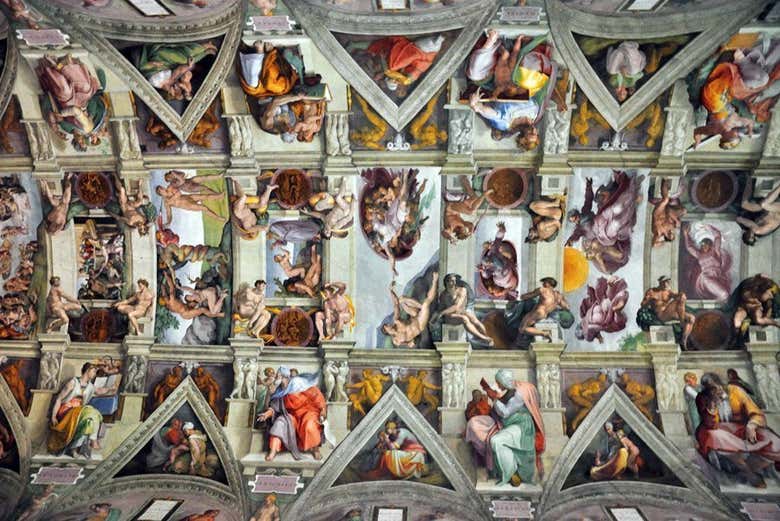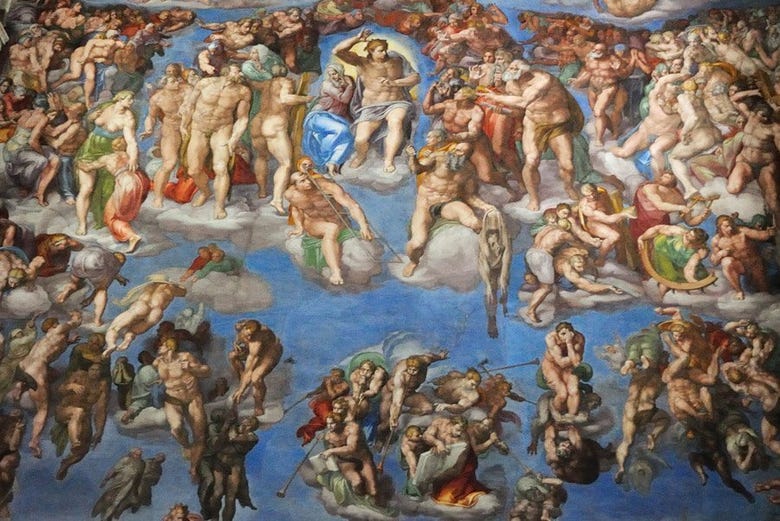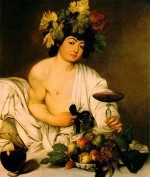
Image via Wikipedia

English: Façade of St. Peter’s Basilica as seen from Saint Peter’s Square. (Photo credit: Wikipedia)
The Vatican City is the world’s smallest independent state and occupies 109 acres. The Vatican City was declared independent from the rest of Italy on February 11, 1929, with the signing of the Lateran Treaty between Pope Pius XI and Mussolini. It has been a sovereign state since 1929 and is ruled by the Pope. Within the Vatican there are numerous interesting attractions to visit, but the best are the following: St. Peter’s Square (Piazza San Pietro), St. Peter’s Basilica and the Vatican Museums, where the Sistine chapel is located.
What to see in St. Peter’s Square
The most impressive part of the square, besides its size, are its 284 columns and 88 pilasters that flank the square in a colonnade of four rows. Above the columns there are 140 statues of saintscreated in 1670 by the disciples of Bernini.
In the center of the square the obelisk and the two fountains, one by Bernini (1675) and the other by Maderno (1614).
The obelisk, which is 25 meters in height, was carried to Rome from Egypt in 1586.
The Vatican is the residence of the spiritual leadership of the Roman Catholic Church.
Its territory is surrounded by the Italian capital city Rome. Priests and nuns make up most of the population.
The Vatican City is a small remnant of the former Papal States of central Italy. These Papal States were conquered by the forces of Italian unification in the mid-19th century. At that time, the popes became “prisoners in the Vatican”.
They were unwilling to leave the confines of the Apostolic Palace until 1929. Finally, the Italian Fascist government negotiated the Lateran Treaty that created the current mini-state.
Francis, the current pope is the first Latin American to be elected to the position. Formerly archbishop of Buenos Aires, Jorge Mario Bergoglio was chosen to succeed Pope Benedict XVI, who reigned from 2005 until 2013.

Pontifical Swiss Guards, dressed in traditional ceremonial dress, are responsible for the security of the Pope

Pilgrimage
The Vatican City itself packs many imposing buildings into its small area: St Peter’s Basilica (completed in the early 17th century) and the Vatican Museums and Art Galleries that are repositories of the priceless art collections of the popes.
Pilgrims travel from all over the world to gather in St Peter’s Square for various ceremonies, such as this beatification of Pope John Paul II in May 2011.
The Dome
One of the most impressive parts of the Basilica is its incredible dome. Its design was started by Michelangelo and continued by Giacomo Della Porta. Carlo Maderno finished the dome in 1614.
This dome has served as inspiration for many other cathedrals and buildings, for example, the Capitol in Washington and St Paul’s Cathedral in London.
Magnificent works of art are housed in the Holy City. Rome’s grand churches were built in the following order: Romanesque, Gothic, Baroque and Neo-Classical. Most of the exquisite Baroque monuments and buildings were erected during the 16th and 17th centuries. Many ancient churches have received newer facades.
On May 6, 1527, the Sack of Rome was perpetrated by German Lutheran and Spanish Catholic troops who resented the wealth of the papacy. The soldiers entered the Vatican as Pope Clement VII was saying a mass in the Sistine Chapel. Swiss Guards were being slaughtered in St. Peter’s Square and the pope was brought to safety in Castel Sant’Angelo.

St. Peter’s Basilica, believed to be the burial site of St. Peter, seen from the River Tiber. The iconic dome dominates the skyline of Rome. St. Peter’s Basilica from the River Tiber. The iconic dome dominates the skyline of Rome. Saint Peter’s Basilica in Rome. Christianity became the dominant religion of Western Civilization when the Roman Empire converted to Christianity. St. Peter’s Basilica, believed to be the burial site of St. Peter, seen from the River Tiber. Saint Peter’s Basilica. (Photo credit: Wikipedia)
The Roman Emperor Constantine (306-337 AD) joined the Christians and before he moved to Constantinople he built several churches in Rome. San Giovanni in Laterano, St. Peter’s Basilica and San Lorenzo Fuori le Mura were all built during Constantine’s reign. Talent and leadership abandoned the newly divided empire and successive waves of Barbarians invaded Rome including the Visigoths, Vandals and the Ostrogoths. By 800 AD, Emperor Charlemagne asserted papal authority and launched another power struggle between the Church and imperial authority. By 1309, the pope moved to the safety of Avignon.

Tomb of pope Julius II by Michelangelo, church San Pietro in Vincoli; Rome, Italy (Photo credit: Wikipedia)
Rome’s imperial legacy lived on in the Catholic Church where Roman senators became bishops, scholars became monks, and philosophers became theologians. The pope or high priest adopted the title originally held by the emperor; “Pontifex Maximus.” Look for this word in the Latin inscriptions in Rome. The grandeur of church rituals is reminiscent of the glory days of Julius Caesar.
The papacy’s supremacy returned to Rome in 1377. In the 1500’s, a glorious rebirth of Rome flourished when the popes invited the most talented architects, painters and sculptors to rebuild Rome’s grandeur during the Renaissance. On April 18, 1506 Pope Julius II (Giuliano Della Rovere) laid the cornerstone for the new Basilica of Saint Peter. Saint Peter’s magnificent basilica was built above the site where Peter the Apostlewas crucified, martyred and buried in the year 64.

Ancient statue of St. Peter in St. Peter’s Basilica, Rome. Possibly the work of Atnolfo di Cambio. Thought by some historians to be much older. Crop of original pic (Photo credit: Wikipedia)

Christ Handing the Keys to St. Peter by Pietro Perugino (1481-82) Fresco, 335 x 550 cm Cappella Sistina, Vatican.
In 1506, Bramante was commissioned by Pope Julius II to renovate St. Peter’s Basilica, originally built by Constantine from 324-329. Emperor Constantine built a glorious crown for St. Peter’s tomb over the site where his bones were preserved. St. Peter was the first apostle and the first pope. Since Rome is a place of pilgrimage, a “Scave Tour” is available with advanced reservations and allows you to visit the tomb of St. Peter and the archeological excavations beneath the basilica. Travel from the Baroque church to the Romanesque sanctuary to the Roman cemetery and tomb of Peter the Apostle. The crypt is located under the Papal Altar.
With over 6 million annual visitors, the Vatican Museums are one of the most-popular attractions in Rome. Established by Pope Julius II during the sixteenth century, it houses thousands of works of art.
What museums are there in the interior of the Vatican Museums?
- Pio-Clementino Museum: Created thanks to the popes Clement XIV and Pius VI, this museum holds the most important Greek works in the Vatican.
- Apartment of Pius V: The work of Pope Pius V, this museum contains Flemish tapestries from the fifteenth and sixteenth centuries, a collection of medieval ceramics and another of medieval miniature mosaics.
- Gallery of the Chandeliers: Roman replicas of Greek originals and enormous chandeliers from the second century A.D. decorate this elegant gallery.
- Ethnological Missionary Museum: This museum contains works of art from all the papal missions of the world, among which there are objects originating from Tibet, Indonesia, India, the Far East, Africa and America.
- Gallery of Maps: Carried out between the years 1580 and 1585, the beautiful maps painted in fresco on the walls of this gallery represent the Italian regions and the possessions of the Church.
- Historical Museum – Carriage Pavilion: In this section you will find coaches, saddles, cars, and even the Vatican City´s first locomotive.
- Gallery of Tapestries: Exhibition of Flemish tapestries created between 1523 and 1534.
- Pio-Christian Museum: The collection of Christian antiquities is composed of statues, sarcophagi and archaeological ruins from the sixth century.
- Pinocoteca: The eighteen rooms in the Pinocoteca building contain pictorial works dating from the Middle Ages until 1800.
- Sobieski Room and the Room of the Immaculate: In both rooms you will find paintings originating in the Italian “Ottocento”.
- Egyptian Museum: Among other pieces acquired by the popes you can find some impressive Egyptian sculptures, besides the prized sarcophagi from the third century B.C. There are also some black basalt statues originating from the Villa Adriana, which are replicas of Egyptian models.
- Etruscan museum: This part of the museum contains elements of ceramic, bronze and gold belonging to the Etruscan civilization.
- Chiaramonti Museum: Created thanks to Pius VII Chiaramonti, this gallery holds thousands of sculptures including portraits of emperors, images of the gods and some funeral monuments.
- Gregorian Profane Museum: Its rooms hold Greek and Roman sculptures from the first to third centuries A.D.
- Borgia Apartment: The apartments that belonged to the Pope Alexander VI Borgia today serve as exhibition rooms for the Collection of Modern Religious Art.
- Raphael Rooms: Rafael and his assistants decorated the apartments of the Pope Julius II with unparalleled taste.
- Sala Della Biga: A monumental figure of marble of a chariot drawn by two horses carried out in the first century A.D. fills the space and gives the room its name.
- Regarded as Michelangelo’s masterpiece, the Sistine Chapel (Cappella Sistina) is a jaw-dropping attraction.



- The Sistine Chapel is one of the greatest treasures of the Vatican City.
- The construction of the building was carried out between 1473 and 1481 during the mandate of Pope Sixtus IV, to whom it owes its current name. The architect responsible for the construction was Giovanni of Dolci. There are magnificent frescoes that completely cover the walls and the ceiling. Some of the most important artists who worked in the chapel are Botticelli, Perugino, Luca and Michelangelo.
-
The ceiling of the Sistine Chapel
All of the frescoes of the ceiling of the Sistine Chapel are the work of Michelangelo, who spent four years painting the vault between 1508 and 1512.
There are nine stories from Genesis that occupy the central area: The scenes from the Drunkenness of Noah to the Separation of Light from Darkness are represented.
The Creation of Adam
The Creation of Adam is the best-known image from the Sistine Chapel. It is located in the central part of the vault and represents the story from Genesis in which God gives life to Adam.
The Final Judgment
Located over the high altar and with some magnificent dimensions (13.7 by 12.2 meters), Michelangelo’s other masterpiece, The Final Judgment, is found. It is a fresco that represents the Apocalypse of St. John.
Decorating the apse occupied five years of Michelangelo’s life, between 1536 and 1541. It was an assignment of the Pope Paul III to cover the murals that existed to that point.
Dr. EveAnn Lovero writes Travel Guides At www.vino-con-vista.com

English: Bernini’s “Gloria” surmounting the “Cathedra Petri”, also by him. Saint Peter’s Basilica, Vatican City. (Photo credit: Wikipedia)
Related articles
- Who built Rome’s Historic Pantheon? (vinoconvistablog.me)
- Santa Maria in Traspontina sits on the site of an Ancient Pyramid in Rome (vinoconvistablog.me)
- Vatican Welcomes 26 Swiss Guards Into Oldest Army (abcnews.go.com)
- Trinita dei Monti Church in Rome at the top of the Spanish Steps (vinoconvistablog.me)
- May 6 in history (homepaddock.wordpress.com)





















